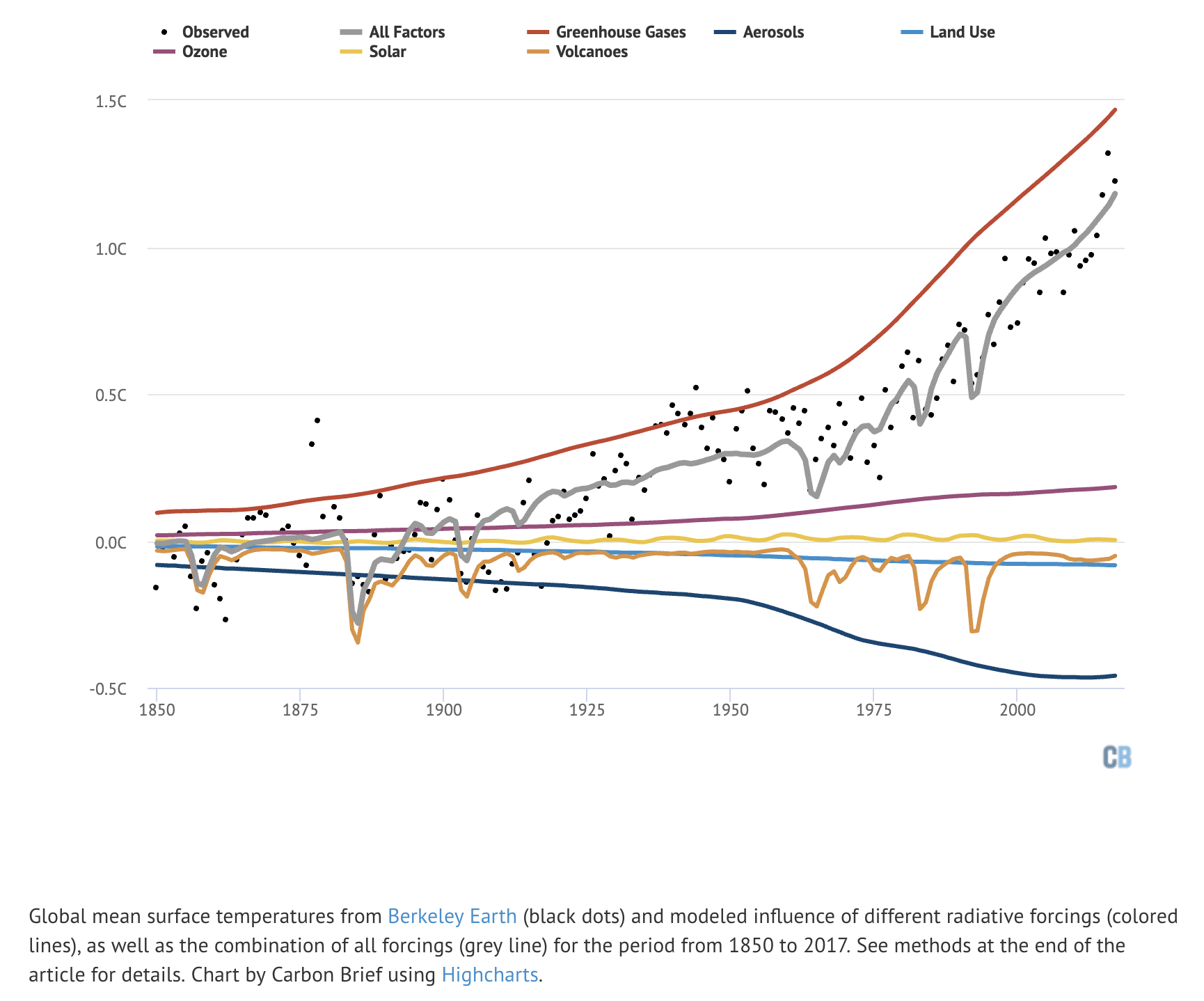
Flawed reasoning: Increased atmospheric CO2 levels increased plant growth in some regions of the world, but the argument that CO2 is not harmful to the planet because it facilitates plant growth is flawed. Human-caused increases in atmospheric CO2 can negatively affect natural ecosystems and human society by causing global warming, ocean acidification, and sea level rise.

REVIEW
CLAIM: “It’s a good thing that we are putting some more carbon dioxide in the atmosphere. If we bring it up to a higher level than it is today, we will get, immediately, an increase in the growth of crops and trees, which is not a bad thing. The scientific method has not been applied in such a way as to prove that carbon dioxide is causing the Earth to warm.”
REVIEW
These claims appeared in a video featuring Patrick Moore, an industry consultant, which has received more than 13,000 views since it was published on Instagram in December 2020. Contrary to what is claimed, the scientific evidence clearly demonstrates a causal link between atmospheric CO2 concentrations and global warming[1-4]. Furthermore, although carbon dioxide can increase plant growth in some environments, it can also negatively impact natural ecosystems and human societies by causing global warming, imbalancing the carbon cycle, and driving weather extremes[1,4,5].
Pre-industrialization atmospheric CO2 levels were around 280 parts per million (ppm)[1]. Since 1950, the burning of fossil fuels, agricultural development, and other human-caused land-use changes have led to steady increases in atmospheric CO2. Today, atmospheric CO2 exceeds 400 ppm (see figure below).
Figure—The Keeling Curve, a daily record of global atmospheric CO2, shows relatively stable CO2 concentrations from 1700 to 1950, as measured by ice-cores. After 1950, CO2 concentrations rose rapidly from 300 to over 400 ppm, as measured at the Mauna Loa Observatory. From Scripps Institute of Oceanography.
Alongside these increases in atmospheric CO2, global land and ocean temperatures have steadily increased (see figure below).
Figure—Global temperature anomaly data relative to the 20th century average temperature from the Global Historical Climatology Network-Monthly data set and International Comprehensive Ocean-Atmosphere Data Set. These data sets show consistent global warming trends. From NOAA.
As stated in a 2014 IPCC report, “Anthropogenic greenhouse gas emissions have increased since the pre-industrial era, driven largely by economic and population growth, and are now higher than ever. This has led to atmospheric concentrations of carbon dioxide, methane and nitrous oxide that are unprecedented in at least the last 800,000 years. Their effects, together with those of other anthropogenic drivers, have been detected throughout the climate system and are extremely likely to have been the dominant cause of the observed warming since the mid-20th century.”[1]
And the 2017 US National Climate Assessment states, “This assessment concludes, based on extensive evidence, that it is extremely likely that human activities, especially emissions of greenhouse gases, are the dominant cause of the observed warming since the mid-20th century. For the warming over the last century, there is no convincing alternative explanation supported by the extent of the observational evidence.”[6]
An analysis of the factors that influence global surface temperatures found that anthropogenic increases in greenhouse gas emissions account for more than 100% of the warming trends observed since 1850 (see figure below).
Figure—The estimated role of different factors influencing global surface temperatures from 1850 to 2017. Observed temperatures are shown in black dots. Global warming over the past 150 years was primarily driven by greenhouse gas emissions (red). From Carbon Brief.
While increased levels of CO2 have increased plant growth in some regions of the world, these effects also decrease with increasing CO2 concentrations[7]. In addition to CO2, plants require water and other nutrients to grow. Scientific studies show the effects of CO2 on plant growth depend on the availability of other nutrients, such as phosphorus and nitrogen[8]. The plant growth benefits of CO2 can also be outweighed by negative climate impacts, such as increasing water stress, heat stress, and ocean acidification[9,10]. In order to assess the overall impact of CO2 on the planet, all known effects of CO2 on land ecosystems and human societies should be evaluated together.
SCIENTISTS’ FEEDBACK
Baird Langenbrunner, Associate Editor, Nature Climate Change:
[Comment from a previous evaluation of a similar claim.]
First, greenhouse gases are well studied, and their properties are nonnegotiable: They absorb and re-emit longwave radiation, whether they’re in a laboratory setting or in the real atmosphere. To back this up with historical evidence, scientists have known since the 1860s that CO2 is a greenhouse gas and since the 1890s that this will affect the heat budget of the Earth through warming. Even then, these claims were based on empirical evidence, and they’re supported by decades of laboratory research.
Second, the link between increased greenhouse gas concentrations and warming continues to be supported by research in the last two decades. One study from 2001 used satellites to measure the type of energy entering and exiting Earth’s atmosphere and concluded that increases in greenhouse gases were responsible for extra heat measured between 1970 and 1997[11]. The authors state that their results “provide direct experimental evidence for a significant increase in the Earth’s greenhouse effect that is consistent with concerns over radiative forcing of climate.” (Here, the term “radiative forcing” refers to the extra energy trapped in the atmosphere by greenhouse gases, cause warming.) A more recent study arrived at similar conclusions, confirming predictions of the greenhouse effect in Earth’s atmosphere and providing “empirical evidence of how rising CO2 levels … are affecting the surface energy balance.”[3] In other words, rising CO2 was linked directly to warming, even when things like plant uptake of CO2 were considered.
Patrick Brown, Assistant Professor, San Jose State University:
[Comment from a previous evaluation of a similar claim.]
The primary empirical evidence that greenhouse gasses cause global warming is the absorption (as a function of wavelength of radiation) of gasses like CO2, CH4 and N2O. This was discovered in 1859 by John Tyndall and has become a part of fundamental physics. Anyone can check this empirical relationship at any time with an absorption spectroscopy device.
The empirical evidence that increases in greenhouse gas concentrations (from fossil fuel burning) are the primary cause of century-scale warming is that observed global temperatures have risen in line with what would be expected from the observed increase in greenhouse gas concentrations and observations of natural drivers of climate change (e.g. solar output and volcanic eruptions) indicate that natural drivers are not causing warming.
Pierre Friedlingstein, Professor, University of Exeter:
[Comment from a previous evaluation of a similar claim.]
This is the usual misleading argument that if CO2 is good for plants, it cannot be bad for the climate. CO2 is needed for plant growth (along with water, nutrients, and energy from the sun)—but it does not change the fact that CO2 is a greenhouse gas. It increases the radiative forcing of the planet and leads to warming, as observed over the last century[5].
Sara Vicca, Postdoctoral research fellow, University of Antwerp:
[Comment from a previous evaluation of a similar claim.]
CO2 is indeed fundamental for most life on Earth. Plants need CO2 to grow and they are at the base of the food chain. However, this fact is often abused to claim that increasing CO2 concentrations is mainly a good thing. Although plant growth is often stimulated by increasing CO2 concentrations, CO2 also causes ocean acidification and warms the planet, thereby generating a cascade of effects from melting of glaciers and sea level rise to altered precipitation patterns and increasing frequency and intensity of extreme weather events such as heatwaves and droughts[1,9,10]. These in turn threaten water and food supplies, and as climate change progresses, this is also likely to undo much of the beneficial effect that CO2 has on plant growth[10].
REFERENCES:
- 1 – IPCC (2014) Climate Change 2014: Summary for Policymakers. Contribution of Working Groups I, II and III to the Fifth Assessment Report of the Intergovernmental Panel on Climate Change.
- 2 – Shakun et al. (2012) Global warming preceded by increasing carbon dioxide concentrations during the last deglaciation. Nature.
- 3 – Feldman et a. (2015) Observational determination of surface radiative forcing by CO2 from 2000 to 2010. Nature.
- 4 – Friedlingstein et al (2019) Global carbon budget 2019. Earth System Science Data.
- 5- Zhu et al. (2016) Greening of the Earth and its drivers. Nature Climate Change.
- 6 – Wuebbles et al. (2017) Executive summary. In: Climate Science Special Report: Fourth National Climate Assessment, Volume I.
- 7- Moore et al. (2017) New science of climate change impacts on agriculture implies higher social cost of carbon. Nature.
- 8- De Graaff et al. (2006) Interactions between plant growth and soil nutrient cycling under elevated CO2: a meta-analysis. Global Change Biology.
- 9 – Doney et al (2009) Ocean acidification: The other CO2> problem. Annual Review of Marine Science.
- 10 – Mbow et al. (2019) IP Food Security. In: Climate Change and Land: an IPCC special report on climate change, desertification, land degradation, sustainable land management, food security, and greenhouse gas fluxes in terrestrial ecosystems. IPCC report.
- 11 – Harries et al. (2001) Increases in greenhouse forcing inferred from the outgoing longwave radiation spectra of the Earth in 1970 and 1997. Nature.





